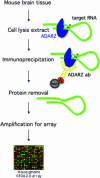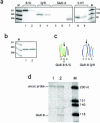A method to find tissue-specific novel sites of selective adenosine deamination
- PMID: 16257978
- PMCID: PMC1275595
- DOI: 10.1093/nar/gni169
A method to find tissue-specific novel sites of selective adenosine deamination
Abstract
Site-selective adenosine (A) to inosine (I) RNA editing by the ADAR enzymes has been found in a variety of metazoan from fly to human. Here we describe a method to detect novel site-selective A to I editing that can be used on various tissues as well as species. We have shown previously that there is a preference for ADAR2-binding to selectively edited sites over non-specific interactions with random sequences of double-stranded RNA. The method utilizes immunoprecipitation (IP) of intrinsic RNA-protein complexes to extract substrates subjected to site-selective editing in vivo, in combination with microarray analyses of the captured RNAs. We show that known single sites of A to I editing can be detected after IP using an antibody against the ADAR2 protein. The RNA substrates were verified by RT-PCR, RNase protection and microarray. Using this method it is possible to uniquely identify novel single sites of selective A to I editing.
Figures




Similar articles
-
A method for finding sites of selective adenosine deamination.Methods Enzymol. 2007;424:289-300. doi: 10.1016/S0076-6879(07)24013-3. Methods Enzymol. 2007. PMID: 17662846
-
Identification of substrates for adenosine deaminases that act on RNA.Methods Mol Biol. 2004;265:199-218. doi: 10.1385/1-59259-775-0:199. Methods Mol Biol. 2004. PMID: 15103075
-
Editing of glutamate receptor subunit B pre-mRNA in vitro by site-specific deamination of adenosine.Nature. 1995 Mar 2;374(6517):77-81. doi: 10.1038/374077a0. Nature. 1995. PMID: 7870177
-
Site-selective versus promiscuous A-to-I editing.Wiley Interdiscip Rev RNA. 2011 Nov-Dec;2(6):761-71. doi: 10.1002/wrna.89. Epub 2011 Apr 21. Wiley Interdiscip Rev RNA. 2011. PMID: 21976281 Review.
-
A-to-I editing challenger or ally to the microRNA process.Biochimie. 2007 Oct;89(10):1171-6. doi: 10.1016/j.biochi.2007.06.002. Epub 2007 Jun 8. Biochimie. 2007. PMID: 17628290 Review.
Cited by
-
Large-scale mRNA sequencing determines global regulation of RNA editing during brain development.Genome Res. 2009 Jun;19(6):978-86. doi: 10.1101/gr.089409.108. Epub 2009 May 6. Genome Res. 2009. PMID: 19420382 Free PMC article.
-
Editing modifies the GABA(A) receptor subunit alpha3.RNA. 2007 May;13(5):698-703. doi: 10.1261/rna.349107. Epub 2007 Mar 16. RNA. 2007. PMID: 17369310 Free PMC article.
-
Transcriptome-wide identification of A > I RNA editing sites by inosine specific cleavage.RNA. 2013 Feb;19(2):257-70. doi: 10.1261/rna.036202.112. Epub 2012 Dec 21. RNA. 2013. PMID: 23264566 Free PMC article.
-
Inosine cyanoethylation identifies A-to-I RNA editing sites in the human transcriptome.Nat Chem Biol. 2010 Oct;6(10):733-40. doi: 10.1038/nchembio.434. Epub 2010 Sep 12. Nat Chem Biol. 2010. PMID: 20835228
-
ADAR2 regulates RNA stability by modifying access of decay-promoting RNA-binding proteins.Nucleic Acids Res. 2017 Apr 20;45(7):4189-4201. doi: 10.1093/nar/gkw1304. Nucleic Acids Res. 2017. PMID: 28053121 Free PMC article.
References
-
- Levanon E.Y., Eisenberg E., Yelin R., Nemzer S., Hallegger M., Shemesh R., Fligelman Z.Y., Shoshan A., Pollock S.R., Sztybel D., et al. Systematic identification of abundant A-to-I editing sites in the human transcriptome. Nat. Biotechnol. 2004;22:1001–1005. - PubMed

